The Need for a New Design-Led Approach
A new, design-led approach is needed to address the complex, wicked problems confronting societies in the 21st century (Hughes & Steffen, 2013; Jensen, 2017) and to seed and catalyze societal transitions toward more sustainable and desirable long-term futures (Porritt, 2013). Problems such as climate change, water security, poverty, crime, and loss of biodiversity are challenging in part due to the high degree of social complexity by which they are characterized. These problems involve multiple stakeholders with conflicting agendas (Dentoni & Bitzer, 2015), straddle disciplinary boundaries, and will require sustained behavioral changes and multiple interventions over short, middle, and long horizons of time in order to be resolved (Australian Public Services Commission 2007; Klein, 1993). Traditional design approaches, characterized by linear processes and de-contextualized problem frames, the objective of which is the swift realization of predictable and profitable solutions, are inadequate for addressing this class of problem (Irwin 2011b; Norman & Stappers, 2016; Sanders & Stappers, 2008). Complex, wicked problems are “systems” problems, meaning they are ill defined, exist at multiple scales, and are interconnected and interdependent (Buchanan, 1995; Coyne, 2005; Rittel & Webber, 1973) and that any intervention (attempted solution) in one part of the system has ramifications elsewhere in unpredictable ways. Wicked problems are continually evolving and cannot be solved by a single solution from a single expert, discipline, or profession. Most significantly, these types of problems took a long time to become “wicked” and will therefore take a long time to resolve.
A more holistic approach is needed to address problems that will take a dozen years or even decades to resolve. This approach must enable practitioners and researchers to distinguish between the consequences and root causes of wicked problems (what we often experience as a problem in our everyday life is really a consequence or symptom of a wicked problem at a higher level of scale). The root causes of wicked problems often involve the social dynamics that permeate them, so a new problem-solving approach must also identify and address stakeholder concerns and conflictual relations. Stakeholder assumptions, expectations, beliefs, and cultural norms must be factored into problem frames and inform solutions. More importantly, collective stakeholder intelligence (Forrester, Swartling, & Lonsdale, 2008; Global Partnership for the Prevention of Armed Conflict, 2009, p. 4) must be leveraged in the design of interventions (solutions). Finally, a new approach must frame wicked problems within the extremely large socio-technical systems within which they evolved (Norman & Stappers, 2016, p. 90). Traditional design approaches decontextualize problems in order to simplify them, focusing on their present-day ramifications; therefore, these approaches can fail to identify and understand the historical origins (roots) of the problem. This approach can result in what we refer to as “pseudo solutions”
-solutions that address symptoms instead of root causes- and can therefore unintentionally cause, or exacerbate, problems elsewhere in the system. Left unidentified, these pseudo solutions can, themselves, evolve into wicked problems.
An example of a pseudo solution is the widely implemented practice used by most municipal water authorities to manage storm water runoff to prevent flooding. For decades, municipalities have built infrastructure that drains storm water runoff (from rain and snow) into streams and rivers -essentially treating the water as waste and removing it from its ecosystem of origin. This pseudo solution is rarely questioned, and therefore its connection to problems such as drought, flooding, and climate change goes unobserved and unchallenged. Kravcik and Lambert (2015, 2016; Kravcik et al., 2016) have discussed the unintended consequences of this practice, which include severe soil dehydration, erosion, loss of vegetation, loss of soil nutrients, depletion of ground water reserves, disruption of local weather patterns, decrease in precipitation and -ultimately- rising sea levels (p. 2). Because the socio-technical and natural ecosystems that form the larger problem
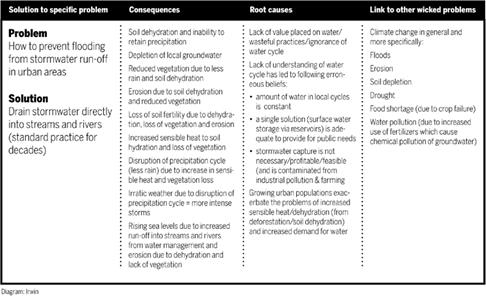
Figure 1 HOW SOLUTIONS CAN UNINTENTIONALLY EXACERBATE WICKED PROBLEMS. Solutions such as storm water management can often have unintended consequences and actually exacerbate the problem they are intended to solve. The figure illustrates the consequences of the solution as well as the root causes that underpin both problem and solution.
context are not taken into consideration, the connection between storm water management and the problems outlined above continues to be overlooked, negatively impacting both climate and ecosystem health (See Figure 1). Solutions like this one, conceived within small contexts that fail to integrate social and environmental concerns into the problem frame, are common. As a result, many purported “solutions” are either the root cause of, or contribute to, countless wicked problems. Therefore, a new approach must be rooted in a deep understanding of systems principles, such as feedback loops, self-organization, and properties of emergence (Capra, 1996; Capra & Luisi, 2014, pp. 442-252; Irwin, 2011b, pp. 240-246), which explain the dynamics within both ecological and social systems.
It is crucial to identify and involve affected stakeholders in wicked problem resolution (Carlsson-Kanyama, Dreborg, Moll, & Padovan, 2008). User and human-centered design approaches seldom have the objective of identifying all affected stakeholders and their concerns, nor do they examine the individual and collective beliefs, assumptions, and cultural norms that have contributed to the problem. For example, traditional design approaches might identify the ways in which an urban water shortage might affect certain user groups, but often the concerns of certain groups are privileged over others (privilege is usually connected to commissioning the research, political capital/power, or holding disciplinary expertise associated with the problem). Traditional research approaches are unlikely to identify the root cause of an urban water shortage as “the lack of value its citizens place upon water” and, yet, core beliefs like this one give rise to practices and behaviors that contribute to the problem.
At a macro systems level, a society’s failure to value water might manifest through collective practices such as dumping industrial waste into rivers and streams, or the rampant use of pesticides and fertilizers that pollute local water supplies. On a micro systems level, everyday practices such as over-watering lawns, owning swimming pools, over-washing clothes, and frequent bathing all contribute to urban water shortages.
The Importance of Involving Stakeholders in Problem Resolution and System Transition
Transition Design draws on approaches from the social sciences to understand the social roots of wicked problems and places stakeholder concerns and collaboration at the heart of the problem-solving process. We use the term “stakeholder” to refer to anyone who has a stake or interest in a specific issue or is affected by a particular problem. The importance of engaging stakeholders in the problem-solving process is well known, particularly in the areas of policy and governance, environmental issues, backcasting, and conflict resolution (Bohling, 2011; Carlsson-Kanyama et al., 2008; Global Partnership for the Prevention of Armed Conflict, 2015; Grimble & Wellard, 1997; Quist & Vergragt, 2006; Simon & Rychard, 2005). As yet, however, stakeholder involvement and analysis has not been integrated into traditional design processes. The Australian Public Service noted that “a key conclusion of much of the literature about wicked policy problems is that effectively engaging the full range of stakeholders in the search for solutions is crucial” (2007, p. 27). There are many well-established methods for engaging stakeholders in relation to complex problem solving, for example: participatory action research (PAR) (Chatterton, Fuller and Routledge, 2007; Cornwall & Jewkes 1995), multi-stakeholder governance (Helmerich & Malets, 2011), multi-stakeholder processes (MSPs) (Global Partnership for the Prevention of Armed Conflict, 2015), and stakeholder analysis (SA) (Grimble & Wellard, 1997).
Stakeholder analysis is described by Grimble and Wellard as a holistic process that can enable a better understanding of a system and the impact of change by identifying and engaging key actors or stakeholders (p. 175). Transition Design argues that stakeholder relations can be seen as the “connective tissue” within a wicked problem, and failure to address these concerns and understand their complex relations are barriers to problem resolution. Conversely, because stakeholder relations permeate the problem (system), they also have the potential to be leveraged in designing interventions aimed at its resolution (Reed et al., 2009). Cornwall and Jewkes (1995) have noted that PAR focuses upon “knowledge for action” (p. 1667), while Chatterton, Fuller, and Routledge (2007) argue that the overriding motivation of participatory research is “aimed at social transformation rather than to use a set of tools aimed at the ‘production of knowledge’ and the ‘solving’ of ‘local’ problems”
(p. 218). The Global Partnership for the Prevention of Armed Conflict has listed several benefits that result from successful multi-stakeholder engagement (2015): The involvement of more actors provides a broader range of expertise and perspectives, meaning that problems can be better analyzed, based upon several different viewpoints. Such analyses can lead to a more comprehensive strategy to address complex conflict situations. MSPs provide the opportunity for greater understanding of different stakeholders’ capacities, roles, and limitations, thus contributing to better coordination of interventions. MSPs can help organizations pool and share resources, including skills, funding, staff time, and logistical or administrative resources. The involvement of multiple stakeholders can be conducive to public outreach and awareness-raising at different levels simultaneously, increasing the reach from grassroots to policy mobilization. In this way, they are a potential multiplier effect when the key messages of the process are communicated to the participants of the respective constituencies. MSP can contribute to building trust among diverse stakeholders, and enable relationships that can outlast the process itself. They can provide a platform for much needed capacity building among practitioners at different levels. Sharing skills and knowledge can enable participants to see problems in new ways, which is also conducive to innovation .
In addition to PAR, other methods, including stakeholder participant workshops, qualitative research, group discussions, storytelling and futuring/foresighting (which are not addressed in this paper), can be used to reveal insights about stakeholder groups.
The Emerging Transition Design Approach
A Transition Design approach for addressing wicked problems and catalyzing systemslevel change is emerging. We call it an “approach” rather than a “process” because designing interventions aimed at transitioning entire systems will require a variety of tools and methodologies, used in different ways -no single, prescribed process will be effective in all circumstances. This section reports on workshops conducted with the city of Ojai, California, to frame their water shortage as a Transition Design problem. These workshops have in part been informed by courses in the topic taught at Carnegie Mellon’s School of Design and in Majorca, Spain in 2017. The approach proposes two key components: a framework that provides logic for bringing together practices outside the design disciplines and a three-phased approach for applying them. It should be stressed that this approach is still in nascent form and is offered here as an invitation to other researchers and practitioners to provide feedback, critique, and engagement in order to evolve a designled approach for systems-level change.
The Transition Design Framework
The framework (See Figure 2) provides a logic for bringing together a variety of practices (knowledge and skillsets outside the design disciplines), situated within four mutually influencing, co-evolving areas relevant to seeding and catalyzing systems-level change: vision (because we need to have clear visions of what we want to transition to), theories of change
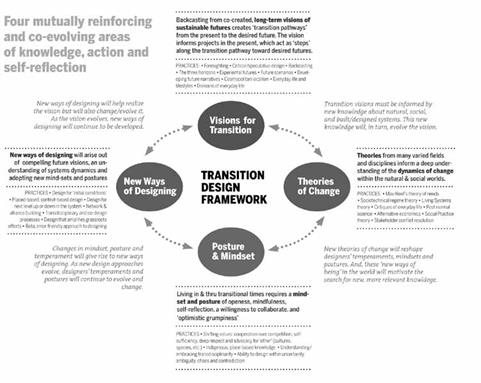
Figure 2 THE TRANSITION DESIGN FRAMEWORK. The Transition Design framework provides a logic for bringing together knowledge and skillsets relevant to designing for transitions.
(because we need a variety of theories and methodologies about how to seed and catalyze change within complex systems), mindset and posture (because we will need to develop postures of open collaboration and self-reflection in order to undertake this work), and new ways of designing, (which will arise out of the previous three areas). Each of these four areas contain a variety of practices that can evolve and change and which together form a “palette” from which practitioners can configure and customize problem-solving approaches.
Transition Design Phases
Practices (See Figure 3) from the framework can be used in a “loosely” phased approach aimed at understanding stakeholder concerns and designing interventions aimed at transitioning the “system.” These phases, reframing the present and future, designing interventions, and waiting and observing, are outlined below.
Phase I-Reframing: Present and future. In this phase, stakeholders undertake a multi-step process to reframe the problem in the present and future. Reframing the problem in the present enables stakeholders to arrive at a shared understanding that is essential in coordinating short and long-term actions. Reframing the future connected to the problem enables stakeholders to co-create visions of a desired future (in which the problem has been resolved) and develop “transition pathways” for getting there (Quist & Vergragt, 2006, p. 1028). Whether it is acknowledged or not, each stakeholder affected by a wicked problem has an implicit or explicit vision of a future associated with it (Rawolle, Schultheiss, Strasser, & Kehr, 2016). We argue that, in the face of the problems confronting 21st century societies, our images/visions of the future are often dystopian, or at best, an extrapolation of the current situation -a future in which the problem has not been fully resolved. Nanus (1992) contends that positive future visions are powerful motivators: “a vision -the mental image of a desirable future- can help to bring about this future by mobilizing people into action geared toward attaining it,” while Polak (one of the early futurists) maintained that “the rise and fall of images of the future precedes or accompanies the rise and fall of cultures” (1973, p. 19). The co-creation of visions of desirable futures helps stakeholders transcend their conflicts and oppositions in the present by creating a future space in which they all agree. Future visions can inform interventions and projects in the present that act as steps along a transition pathway toward desired futures (See Figure 4). Phase one is referred to as a process of “reframing” both problem and context in large, spatio-temporal contexts. The concept of framing was first introduced by Bateson (1972) and subsequently adopted in disciplines such as psychology, linguistics, and sociology. Lakoff describes frames as “the mental structures that shape the way we see the world” (2004, p. xi-xii). These structures or cognitive models are influenced by metaphors, norms, mass media, political movements, and personal history. Rittel and Webber (1973) maintained that wicked problems are intractable, in part due to the multiple stakeholders who are affected by them and who have opposing points of view and conflicting agendas. One of the reasons stakeholders remain in opposition to one another is because they each bring with them their own limited understanding of the problem (the problem frame), as well as fears, expectations, and beliefs about the problem itself, all of which are influenced by individual and collective “frames”.
The reframing phase of the Transition Design process challenges existing problem definitions and expected outcomes and seeks to foster consensus and empathy among stakeholders. It acknowledges existing stakeholder frames and facilitates a reframing process aimed at achieving a shared understanding of the problem by identifying the narratives, metaphors, and conflictual expectations and belief systems that underlie it. Recently, an approach to reframing has been trialed both in classroom projects and in two workshops held with the community of Ojai, California. However further experimentation is warranted, and critique, feedback, and exploration by other researchers is encouraged.
Mapping the problem. Problem mapping is a process in which stakeholders collaborate to develop a visual representation of a wicked problem, then identify as many relationships (interdependencies and interconnections) within it as possible. Types of relationships include oppositions and affinities between stakeholders, connections and interdependencies
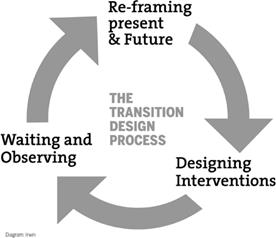
figure 3 (Left) THE THREE PHASES OF THE TRANSITION DESIGN APPROACH. The emerging Transition Design approach proposes three phases of reframing, designing, and observing. This is an iterative process that will likely extend over years or even decades in order to resolve a wicked problem and/ or shift a socio-technical system.
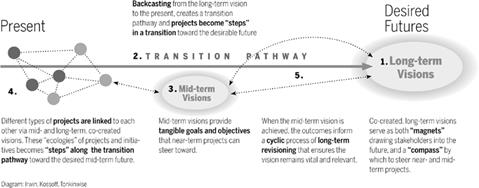
Figure 4 (Down) LINKING PROJECTS AND INITIATIVES TO MID AND LONGTERM FUTURE VISIONS. Backcasting from mid and long-term future visions creates a “transition pathway” along which linked projects and initiatives serve as steps toward the desired future. This figure shows how the Transition Design principles of futuring, backcasting, and linking/amplifying can be used together to seed and catalyze systems-level change.
between areas of the problem that could be causal or connected via feedback loops, etc. The problem mapping process is intended to: (a) enable stakeholders to arrive at a shared understanding of the problem; (b) develop an appreciation of the limited perspective and specialized knowledge held by each stakeholder group; (c) enable stake holders to adopt new collaborative postures in order to transcend differences (the process introduces an element of “play” and co-discovery intended to build trust and empathy); (d) provide stakeholders with an understanding of and appreciation for the complexity of the problem; (e) position stakeholder participants as advocates of the collaborative process within the wider community and represent other stakeholder viewpoints within their group; and (f) create a visual artifact (problem map) that can be continually updated and validated through qualitative research and informal feedback and that can serve as a rallying point for community action and awareness.
The importance of achieving a shared understanding of the problem among stakeholders cannot be stressed enough. The Australian Public Service Commission in a 2007 report argued that a lack of shared understanding can result in the belief held by certain stakeholder groups that their view of the problem is correct and that they alone should be able to specify and control a course of action aimed at its resolution. The report goes on to say that:
It can be extremely difficult to make any headway on an acceptable solution to the wicked problem if stakeholders cannot agree on what the problem is. Achieving a shared understanding of the dimensions of the problem and different perspectives among external stakeholders who can contribute to a full understanding and comprehensive response to the issue is crucial. (p. 27)
The report argues that arriving at a 100 percent agreement is neither necessary nor feasible. Rather, it is important to achieve a general, shared understanding of the problem and appreciation for the diversity of stakeholder perspectives and positions. This, in turn, becomes the foundation for a productive dialogue based upon empathy and trust.
When stakeholders undertake a collaborative problem-mapping process, they are more likely to transcend the frames they bring with them and collectively arrive at a new problem definition (reframing). Problem definition is a complementary approach in which Bardwell (1991) argues that people access information and solve problems based upon the mental models or cognitive maps that they have assembled over the course of their lives. In the problem definition and resolution process, people draw on these models subconsciously, even when they encounter new situations. This means that new problems are framed exactly like the old ones and therefore, more effective potential solutions are overlooked (pp. 604-605). “Problem definition ramifies throughout the problem-solving process, reflecting values and assumptions, determining strategies, and profoundly impacting upon the quality of solutions” (p. 605). Essentially, how the problem is framed is how it will be understood and acted upon. Because most people have not tried to confront or solve a wicked problem before, it is imperative that old frames and cognitive models are set aside in order to reframe the problem using group intelligence.
Transition Design argues that wicked problems require new cognitive models and inclusive problem-solving approaches. Although traditional design approaches may employ a range of user and human-centered research techniques, they rarely bring multiple stakeholder groups together with the objective of co-creating a new problem definition and identifying stakeholder concerns, beliefs, and assumptions.
This type of collaboration “potentially avoids the cost of resolving adversarial conflicts among stakeholders in the long term” (Bramwell & Sharman, 1991, p. 392). However, because the distribution of power among stakeholders is almost always unequal (Baur, Elteren, Nierse, & Abma, 2010, p. 233), if one or two groups are in the position to frame (define) the problem, their needs and concerns will be privileged over those of others. Disregarding certain stakeholder groups and proposing solutions that overlook or even undermine their needs is a common obstacle in resolving wicked problems. The Transition Design approach favors a consensus-based, multi-stakeholder approach that can aid in transcending oppositions, conflict, and the limitations of old cognitive maps and frames and can equalize power relations.
Visually mapping a wicked problem via stakeholder collaboration will challenge designers to develop new tools and visualization methods. There are numerous digital mind-map- ping and wicked problem visualization tools available; however most have been conceived within a reductionist paradigm that focuses on the object or “node” and minimizes the importance of the connections or the “webs of relationships and interactions” within a problem. Transition Design argues that the social relationships within wicked problems are often discounted or overlooked altogether. New digital toolsets must be developed that can accurately represent the nuances of stakeholder relations and their connections at multiple levels of scale within a wicked problem. It is equally important to develop new analog tools that facilitate collaborative stakeholder problem mapping in a workshop setting.
Although there are limitations inherent within the workshop format, it can still serve as a valuable way to foster understanding and empathy among stakeholder groups. The Ojai workshops (Irwin, 2017) used a simple approach that provided stakeholder groups with a large wall canvas with predetermined categories onto which they were asked to map the wicked problem of the Ojai water shortage. The categories included (a) social issues, environmental issues, (c) infrastructure issues, (d) political issues, and (e) economic issues. Participants used Post-it notes to identify as many facets of the problem as possible within each category. Once the map was populated, stakeholders took time to study it and discuss the results. Participants were surprised to discover facets of the problem of which they had been unaware and encounter opposing viewpoints on aspects of the problem that they had taken for granted as “true”. For instance, water experts focused on the infrastructure area of the map and identified multiple problems resulting from an antiquated municipal water infrastructure, something that most residents are unfamiliar with. Residents, in contrast, were able to discuss everyday hardships and inequities caused by the water shortage, as well as the ways in which daily practices (such as overwatering lawns and landscaping choices) or the growth of short-term rental properties (such as Air BnB) exacerbated it.
Once participants familiarized themselves with the entire problem map, they were asked to draw connections among its various elements. There are many different types of relationships that can be mapped within a wicked problem such as the Ojai water shortage: interdependencies (between the social issue of residents’ lack of awareness/ignorance of the water shortage and the political issue of a lack of support for developing new policies, such as taxation or restricting water use); causal relationships (the economic issue of businesses promoting tourism and development is causally related to the environmental issue of the depletion of local water reserves and the environmental issue of declining ecosystem health due to the increased demand for water); conflictual relationships (the economic issue of increased tourism is at odds with the social issue of residents facing a water shortage while tourists in the hotels are not compelled to conserve); affinities (between the political issue of the need to pass new laws limiting water use and alignment with the environmental issue of conservationists’ desire to protect the integrity of local water sources); and relationships that feedback on each other (the economic issue of marketing to increase tourism increases the popularity of Ojai as a destination, which results in more people, using more water, which exacerbates the water shortage -a positive feedback loop). These relationships comprise the dynamics within wicked problems that usually go unaddressed by traditional design approaches.
Bringing stakeholder groups together in a workshop format to reframe/redefine a wicked problem can transform a potentially conflictual or confrontational discussion into a process of discovery and co-creation, as evidenced in the Ojai workshops. Within the brief workshop format, there was not time to develop a complete, accurate problem map, but it has the potential to become a strategic artifact and rallying point when validated through additional stakeholder input and qualitative research aimed at capturing all stakeholder perspectives.
-Mapping stakeholder concerns and relations. In this step, all stakeholder groups are identified and their feelings, concerns, and beliefs about the problem itself are revealed in a process that brings together aspects of both actor mapping and stakeholder analysis (FSG, 2017; Reed et al., 2009). Stakeholder feelings are frequently overlooked, but they often lie at the root of wicked problems, and, as yet, there is no design-led process aimed at identifying and integrating these feelings into the problem frame.
There are many well documented approaches used to identify and resolve stakeholder relations, including needs-fears mapping (Wageningen University, 2017), conflict analysis tools (Mason and Rychard, 2005), and multi-stakeholder processes (Hemmati, 2002), to name a few. These approaches delve more deeply into understanding stakeholder differences, mindsets, and relations than do traditional design approaches (such as actor and stakeholder maps, which often privilege the consultant’s, expert designer’s, or client’s point of view), and offer collaborative processes for resolving conflicts and facilitating more meaningful collaboration and understanding. What is lacking, however, is a designled component that can lead to tangible action in the form of designed interactions, communications, and artifacts that motivate, educate, and facilitate new behaviors and outcomes. Transition Design proposes that many stakeholder conflict resolution methods from the social sciences can inform a new, design-led approach that mediates stakeholder relations as a strategy in addressing wicked problems.
Identifying stakeholder fears/concerns and hopes/desires is essential to understanding a wicked problem and developing effective interventions aimed at its resolution. Transition Design differs from other design-led approaches in its emphasis on understanding the assumptions, beliefs, and cultural norms related to the problem for each stakeholder group. We argue that understanding stakeholders’ deepest feelings about the problem and the way in which their individual and collective belief systems (worldviews) (Clarke, 2002; Kearney, 1984; Kuhn, 1962; Lent, 2017; Woodhouse, 1996) affect their view the problem is fundamental to resolving differences and/or transcending them through the co-creation of visions of desirable futures.
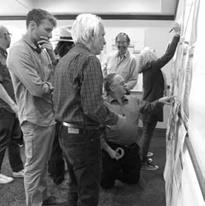
Figure 5. WORKSHOP PARTICIPANTS MAPPING STAKEHOLDER CONCERNS & RELATIONS. Participants at a Transition Designworkshop held in Ojai, California, May 2017, take part in an exercise to map stakeholder concerns and areas of conflict and alignment.
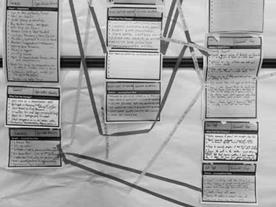
Figure 6 MAPPING STAKEHOLDER RELATIONS. Workshop participants mapped areas of alignment (light colored tape) and conflict (dark colored tape) between their fears/concerns and hopes/desires.
In the Ojai workshop, stakeholder groups were asked to list their fears and concerns related to the regional water shortage and, in a second step, their hopes and desires connected to its resolution. The results were hung on a long wall and groups were then asked to find points of opposition or alignment among the lists. Each stakeholder group was given a roll of green and a roll of red tape and asked to connect points of opposition (red) and points of affinity and alignment (green) (See Figures 5 and 6), to which they added notes explaining the nature of the connection. This informal and rather “boisterous” process interjected an element of discovery, surprise, and “play” into what would ordinarily have been a tense and potentially confrontational debate among diverse stakeholder groups about how to solve the problem. Within this context, stark oppositions (instances in which one stakeholder group’s greatest fear is another’s fondest wish) could be identified in a spirit of discovery and friendly competition to see how many connections could be found. Dialog between opposing groups was collegial, even lighthearted. In general, stakeholders were surprised at the number of lines of affinity among groups, and it became a point of positive speculation and discussion. A final discussion around the large, sprawling map and web of concerns, fears, hopes, and desires centered on how red lines of opposition could be resolved and green lines of affinity leveraged, essentially shifting the focus from differences to the objective of transcending them.
The visual artifact (problem map) served to acquaint stakeholders with the diversity of viewpoints connected to the wicked problem and challenged the commonly held belief that a single solution, developed by a single stakeholder group with relevant domain expertise (and therefore, ownership), could solve the problem. This stage of the process revealed unexpected areas of agreement, alignment, and complementarity that sparked dialog among stakeholders with generally opposing agendas, and the results have the potential to lead to consensus and collaboration in areas of common interests and objectives. In a final, self-reflective exercise, stakeholder groups examined the cultural norms, beliefs, and assumptions that contributed to or were the root cause of the water shortage. This is challenging work, because few of us are skilled in examining our own worldviews and mind-sets as the roots of a wicked problem. Once stakeholder groups identified their cultural norms, beliefs, and assumptions that contributed to the problem, they were asked the question “If by 2050, the problem has been resolved, how would cultural norms, beliefs, and assumptions have changed?” At the conclusion of the exercise, each stakeholder group had two sets of beliefs, assumptions, and norms: one set for the present day (that they felt had contributed to the problem) and a second “future” set (that they believed would be the basis for the long-term resolution of the problem). As an example, one group articulated their present-day beliefs about the water shortage as “We believe that water is something to be bought and sold because there will always be enough of it.” This contrasted with their set of 2050 beliefs: “Water is precious and sacred, it is part of ‘the commons,’ and everyone has a right to enough.” This exercise, while challenging, marked a distinct change in tone in the workshop. Participants appeared to slow down and became more speculative, even contemplative. Encouraging participants to adopt this new posture was essential to the following step.
Future visioning. The Transition Design process aspires to draw on a range of foresighting techniques that will enable stakeholders to co-create compelling visions of longterm, lifestyle-based futures in which the problem has been resolved and most stakeholder needs have been met. These visions can act both as a magnet that pulls communities toward a desired future and as a compass to guide their actions in the present (projects and initiatives).
The intersection of foresight studies and design has given rise to several new areas of research and practice such as “design fiction,” “speculative/critical design,” and “experiential futures” that are concerned with envisioning and prototyping possible or even preferable futures. Transition Design argues that these approaches can contribute to positive shifts in the mindsets, behaviors, and practices that have contributed to wicked problems. Dunne and Raby (2013) note that a “futures” approach “thrives on imagination and aims to create spaces for discussion and debate about alternative ways of being, and to inspire and encourage people’s imaginations to flow freely. Design speculations can act as a catalyst for collectively redefining our relationship to reality” (p. 2). Candy and Dunagan (2017) note that “experiential futures” are able to catalyze “high quality engagement, insight, and action to shape change, using whatever means fits the situation” (p. 3), and seek to provide individuals and groups with glimpses of a future that resonates more deeply than other modalities. Transition Design argues that until people are able to clearly envision (and become enthusiastic about) a future in which the problem has been resolved and their needs met, they will remain resistant to change and pessimistic -or even apathetic- about the likelihood of resolution.
New tools and approaches for enabling stakeholders to co-create compelling visions of long-term futures are needed. Stakeholder groups in the Ojai workshop undertook a visioning exercise called “Snapshots from 2050” in which they co-created a future, lifestylebased narrative in which the water shortage had been resolved. Groups were provided with relevant examples of “day in the life” narratives to ensure they remained focused on the holistic process of envisioning/reconceiving entire lifestyles rather than the dominant, reductionist approach of envisioning discipline-based solutions. Groups were provided with narrative word/image templates and charged with portraying a glimpse of what everyday life in 2050 would be like for their stakeholder group if the problem were resolved. Question prompts included: “What would the resolution of the problem make possible for your stakeholder group?” “What might you be able to do/accomplish that you currently cannot?” “In what ways would your everyday life (practices, surroundings, profession, home life) look different or be better if the water shortage were resolved?”
Groups used their previously articulated 2050 beliefs, assumptions, and cultural norms as the springboard for the futuring exercise. They were asked to consider how their 2050 worldview might inform new practices, behaviors, and designed interactions and how artifacts would be part of their narrative. Participants also referenced their earlier lists of fears/concerns and hopes/desires and speculated about how they would have been resolved or fulfilled in the future; they then used them to develop more concrete examples for the day-in-the-life narratives. Each stakeholder group hung their future narratives on a wall and presented to the entire group. In a final step, groups reprised the exercise of drawing green lines of affinity and red lines of opposition between the different narratives. The results showed many green lines due to the striking similarities among the visions and few red lines of opposition. Our hypothesis (which can only be borne out through additional extensive research with more groups) is that the “space” participants enter into when envisioning a desired, common future enables them to transcend opposition and conflict in the present and focus on affinities and similarities in a commonly envisioned, hypothetical future. Exploration should be done on whether qualitative research could inform this and other visioning processes.
Backcasting. Backcasting is a term introduced by Robinson (1982) that is often used as an approach to address long-term, complex societal issues that involve multiple stakeholder groups (Carlesson-Kanyama et al., 2008; Quist & Vergragt, 2006). Backcasting begins with defining a desirable future then backcasting to the present to create a transition pathway along which projects, initiatives, and programs are positioned as initial steps in that transition. Backcasting differs from forecasting in approach. Forecasting extrapolates current trends (based in dominant paradigms out of which the problem arose) into the future, whereas backcasting attempts to define interesting futures, analyze their consequences, and determine the conditions necessary for these futures to materialize. Robinson (1982) notes:
The major distinguishing characteristic of backcasting analysis is a concern, not with what futures are likely to happen, but with how desirable futures can be attained. It is thus normative, involving working backwards from a particular desirable future end-point to the present, in order to determine the physical feasibility of that future and what policy measures would be required to reach that point. (p. 337)
Transition Design proposes backcasting as a collaborative activity in which stakeholder groups can leverage their visions of desirable futures to inform tangible, consensus-based action in the present.
Due to time limitations, Ojai workshop participants did not delve deeply into this process. Groups were asked to create a transition pathway from the present to their 2050 vision and use Post-it notes to speculate on what projects, initiatives, and milestones would be necessary (between the present and 2050) to achieve the vision. This technique draws on the approaches used by Porritt (2013), Dreborg (1996), and Sharpe (2013) in using backcasting to envision a process of societal transition. Workshop organizers observed that participants were highly challenged when asked to think in long horizons of time and struggled with the exercise. Further research must be undertaken to evolve the backcasting process for Transition Design, and it is likely that a variety of approaches can be employed and combined in different ways. Irwin, Tonkinwise, and Kossoff (2015) have proposed an iterative and cyclical process for backcasting and visioning (See Figure 4) as the slow process of problem resolution and societal transitions unfold. This process ensures that long-term thinking becomes common and that future visions do not become fixed and static, but rather, are in a continual process of evolution and change, based upon feedback and outputs from present and near-term projects (steps in the transition).
Once a transition pathway has been mapped and concepts for projects and initiatives that can serve as steps toward the desired future are explored, the second phase of the Transition Design process begins.
Phase II-Designing interventions. In phase 1, stakeholders develop a shared understanding of the problem and a vision of a desired future. Phase 2 situates both the wicked problem and the vision within a large, multi-level, spatio-temporal context. It also draws on tools and approaches from outside the design disciplines to aid in understanding extremely large problem frames and in developing interventions for the problem’s resolution. Most design-led approaches situate problems within small, easy to manage contexts and problem frames whose objective is the realization of swift, profitable solutions. We argue that wicked problem resolution requires myriad interventions at multiple levels within extremely large spatio-temporal contexts. Wicked problems exist at multiple levels of scale and always have their roots in the past because it takes years, decades, or even longer for problems to become wicked. It is necessary to look at both higher and lower systems levels to understand the problem’s ramifications and consequences in the present, as well as looking to the past to understand the problem’s root causes and evolution.
In essence, phase two of the Transition Design process involves looking up and down systems levels in space and backward and forward in time in order to contextualize and address the wicked problem framed in phase I -both dimensions play a role in devising interventions (See Figures 7 and 8). Delineating and investigating large systems contexts is what distinguishes the Transition Design process and makes it possible to (a) under stand the
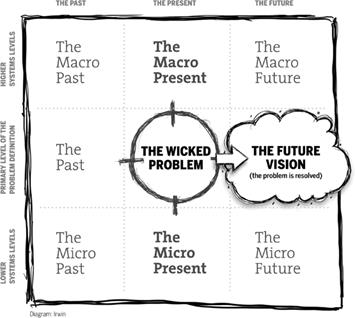
Figure 7 FRAMING WICKED PROBLEMS WITHIN LARGE SPATIO-TEMPORAL CONTEXTS. Setting a large spatio-temporal context for a wicked problem involves looking up/down systems levels in the present and back and forth in time (past and future) in order to understand the consequences and root causes of the problem and develop a compelling future vision that will inform the design of present-day interventions.
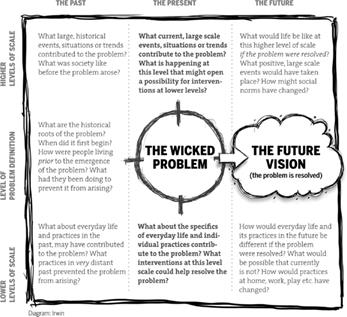
Figure 8. EXPLORINGTHE SPATIO TEMPORAL CONTEXT FOR A WICKED PROBLEM. The example shows a series of questions aimed at exploring the large spatiotemporal context within which the problem is framed
present-day ramifications and consequences of wicked problems (looking up and down systems levels); (b) understand how wicked problems evolved and identify their root causes (in the past); and (c) intentionally transition the system toward preferred futures over multiple time horizons.
Due to the limited format of this paper, only a few of the strategies we have found useful for surveying the spatio-temporal context of a wicked problem and developing more appropriate criteria for interventions are presented below.
Multi-level perspective. The MLP framework (See Figure 9) is a conceptual framework used to investigate how large socio-technical systems (the interactions between people and complex societal infrastructure) transition over long periods of time. The term sociotechnical system was first used by Trist, Bamforth, and Emery at the Tavistock Institute (Trist & Murray, 1993) and was later developed by researchers and scholars in northern Europe as sustainability transitions and socio-technical transition management. The MLP framework describes three distinct systems levels in which events unfold, infrastructure and artifacts arise, and webs of interaction occur: the macro (the landscape), the meso (the regime), and the micro (the niche) (Geels, 2006). Kossoff, Tonkinwise, and Irwin (2015) describe these interactions as “social, technical, institutional, infrastructural and normative” and argue that the networks of relationship between these levels and their various actors/factors become progressively more “entrenched” and resistant to change as their scale increases, eventually becoming “locked in” to a particular trajectory (pp. 5-6). Rotmans and Kemp (2003) describe the actors and events at each of the three levels. At the macro-level the societal landscape is determined by changes in: the macro economy, political culture, demography, natural environment, and worldviews and paradigms. This level responds to relatively slow trends and developments. Its seismic undercurrents can play an important role in speeding up or slowing down a transition, but its geology is for the most part unyielding. At the meso-level operate the social norms, interests, rules, and belief systems that underlie strategies of companies, organizations, and institutions and policies of political institutions. At this level the dynamics is determined by dominant practices, rules, and shared assumptions that are most geared towards optimizing rather than transforming systems. At the micro-level (niche-level) act individual actors, technologies, and local practices. At this level, variations to and deviations from the status quo can occur as a result of new ideas and new initiatives, such as new techniques, alternative technologies, and social practices.
Situating a wicked problem within an MLP context is useful for several reasons: (a) it aids in understanding the historical evolution of the problem, which is essential in identifying and addressing root causes (which always exist at multiple levels of scale); (b) it is useful in identifying both intractable, entrenched areas within the system and opportunities for disruption (often incubated at the niche level, but large events at the landscape level can open up opportunities at lower levels); and (c) it provides a large enough context to reveal connections and interdependencies among other wicked problems that can inform strategies for more powerful interventions aimed at exponential change (i.e., killing two birds with one stone).
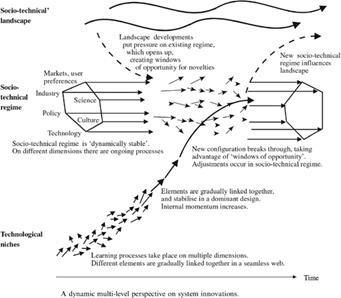
Figure 9 THE MULTILEVEL PERSPECTIVE (MLP). The multi-level perspective (MLP) on systems innovation. From Geels (2006). Reproduced with permission from Technology in Society Journal 28, 448.
“Reading” the social-technical terrain with the MLP can reveal what Meadows (1999) has called “places to intervene in a system.” Although the MLP has drawbacks (Kossoff et al., 2015), it is nevertheless a useful way of understanding the connections and dynamics among multiple wicked problems within a large spatio-temporal context, which is a crucial precursor for designing interventions at multiple levels of scale. For more on socio-technical transitions and the MLP see Grin, Rotmans, and Schot (2010), and Gaziulusoy and Brezet (2015).
The domains of everyday life and lifestyles. Everyday life and lifestyles are often overlooked as legitimate spheres in which to consider and address problems (Debord, 2002; de Certeau, 1984; Lefebvre, 1991), and is the primary conceptual space within which Transition Design interventions should be conceived and implemented. Everyday life can be seen as an emergent property of people striving to satisfy their needs. The SPREAD reports (2012a, 2012b, 2012c) establish lifestyles as the area in which “our sense of self, our world views and our values” (2012a, p. 17) come together and reflect how we live, spend our time, and interact with others. The reports have identified “lifestyle change” as a key strategy for addressing wicked problems in multiple sectors and the basis for conceiving more holistic and appropriate present-day interventions and future visions.
The Domains of Everyday Life is a conceptual framework developed by Kossoff (2011) to describe everyday life in terms of the nested and interdependent social forms that exist at multiple systems levels that are characteristic of healthy societies. Kossoff argues that because problems are always experienced within the context of our individual and collective everyday lives, this is the natural context within which to address their resolution. The approach aims to create a framework for envisioning a sustainable future, provide a model for transdisciplinary collaboration and logical integration among projects, and embody “a more qualitative and humane understanding of sustainability than recent technocratic and economistic appropriations of this concept have come to do” (Kossoff, 2011, pp. 123-124). The domains of everyday life framework is similar to the MLP in its examination of systems levels that extend from the micro through the macro, but it differs in its emphasis on sustainable lifestyles and the quality of everyday life.
Kossoff proposes five domains of everyday life: the household, the neighborhood or village, the city, the region, and the planet, as “semi-autonomous and mutually interdependent wholes” (2011, p. 133). The vitality and health of these domains is directly related to individuals’ and communities’ ability to control the “satisfaction of their needs” (Max-Neef, 1992) at each specific level of scale. The SPREAD Sustainable Lifestyles 2050 report (2012a) defines lifestyle as “the way we live our lives that allows us to fulfill our needs and aspirations” (p. 9) and argues that unsustainable lifestyles are related to myriad wicked problems. The SPREAD research was undertaken primarily to inform policy changes that support sustainable shifts in lifestyles in four key areas: “consuming (food, household and leisure consumer products), living (the built environment and homes), moving (individual mobility and transport), and health and society (health, well-being, ageing, and equity)” (p. 11). The report lays out several approaches that have the potential to inform Transition Design solutions at multiple levels of scale.
Identifying lifestyles and everyday life as leverage points for change is central to the Transition Design process. Modern day fragmentation of knowledge into disciplines and specialties has become an entrenched barrier to the kind of transdisciplinary collaboration that is crucial to addressing wicked problems (Australian Public Service Commission, 2007; Block, 2008). Individuals from specific disciplines, working independently or only in collaboration with closely related fields, are unable to formulate solutions that fully address wicked problems and meet all stakeholder needs. Two important areas overlooked by most expert-driven approaches are belief systems and everyday practices, both of which contribute to wicked problems. Shifting the focus from disciplinary, “siloed” solutions, to re-conceptualizing everyday life and lifestyles, establishes belief systems, cultural norms, behavior, and practices as leverage points for change and creates an integrative space in which experts and laypeople alike can meet on equal footing to design and implement more holistic and appropriate interventions.
Manfred Max-Neef’s theory of needs and satisfiers. Both the domains of everyday life and SPREAD approaches emphasize the importance of needs satisfaction. Transition Design draws on economist Max-Neef’s theory of needs (1991), which differs from other theories in its decoupling of needs and satisfiers and in its argument that needs encompass both the material and non-material and are non-hierarchical, finite, and universal (all people everywhere have the same, limited, set of needs). Conversely, it argues that the ways in which people satisfy their needs are limitless and unique to their era, culture, belief system, age, and geographic location (See Figures 10 and 11). Kossoff emphasizes the connections between needs satisfaction, diversity, and place, arguing that “how needs are satisfied… gives rise to the diversity of forms of everyday life that have arisen all over the planet, and that make everyday life specific to place” (2011, p. 130). Transition Design expands on Max-Neef’s theory in its contention that needs can be satisfied in either sustainable or unsustainable ways (Irwin, 2011a). Establishing needs satisfaction as a criterion in the re-conception of everyday life and lifestyles is an important strategy for challenging the dominant socio-economic and political paradigms within which most wicked problems have evolved and can lead to the design of more powerful interventions.
In modern societies, basic needs may go unrecognized and/or unmet because we confuse needs, which are finite and universal, with wants and desires, which are limitless (Irwin, 2011a). Unmet genuine needs lie at the root of many complex problems. For example, Max-Neef, (1991) attributes issues such as bigotry, elitism, authoritarianism, etc., to the unmet need for understanding. This is because the actions, behaviors, and artifacts used to satisfy a particular need can, unintentionally, prevent, subvert, or inhibit its satisfaction. Conversely, “synergistic satisfiers” (Max-Neef, 1991, p. 36), which satisfy several needs simultaneously, can become a key strategy for evaluating and critiquing existing situations and designing interventions aimed at resolving wicked problems. We refer to these as “synergistic solutions” or “synergistic interventions”.
Max-Neef’s theory can be used as a Transition Design approach in two ways: to critique lifestyles and everyday life at multiple levels of scale to ascertain whether genuine needs are being met or undermined, and as a new criterion for framing problems and designing interventions (solutions). For example, a proposed or existing solution could be evaluated upon the basis of whether it is “synergistic” (satisfying several needs simultaneously) or destroying/ inhibiting (often solutions satisfy wants/desires and overlook or undermine genuine needs).
Social practice theory and design for behavior change. Both social practice theory and design for behavior are micro-level approaches that can be used in understanding how people’s practices and behaviors contribute to wicked problems and how they can become strategies for designing interventions aimed at their resolution.
Whereas the MLP framework takes a macro view and focuses on niche incubation (developing protected, experimental solutions at lower systems levels) against the backdrop of large, moving events within the socio-technical landscape, social practice theory examines:
The multiplicity of ‘little pictures,’ taking the ‘practices’ of people in their everyday lives ‘as the unit or focus of attention’ (Shove and Walker, 2010, p. 471). It is through such practices, day after day -bathing, eating, driving, dressing, shopping and so forth- that people sustain themselves, but also contribute toward environmental degradation. (Kossoff et al., 2015, p. 7)
Social practice emerged out of theories proposed by sociologists and philosophers (Bourdieu, 1997; Giddens, 1984; Schatzki, 2010); however the work of Shove, Pantzar, and Watson (2012) is most relevant to the emerging Transition Design process. Social
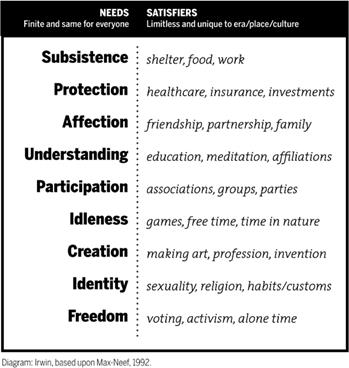
Figure 10 MAX-NEEF’S LIST OF NEEDS AND SATISFIERS. Manfred Max-Neef’s list of finite human needs and ways in which those needs might be satisfied. Needs are finite and universal, while satisfiers are limitless and specific to geographic location, culture, era, etc. Based on Max-Neef (1991).
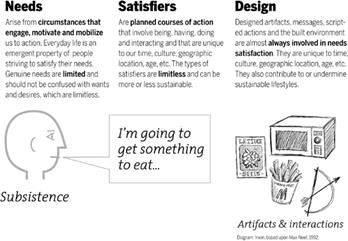
Figure 11. THE RELATIONSHIP BETWEEN NEEDS, SATISFIERS AND DESIGN. Needs motivate us to take planned courses of action to satisfy those needs. Satisfaction of needs often involves designed artifacts, communications, environments, and interactions, which are always specific to geographic location, era, culture, etc. Based on Max-Neef (1991).
practices are the micro-components of everyday life and lifestyles and their importance is often overlooked by traditional user-or human-centered approaches that tend to “focus on single product-user interactions and specific moments in time” (Kuijer & de Jong, 2011, p. 1) within extremely limited, for-profit contexts. By contrast, social practice theory examines how “constellations” of practices (interactions) can contribute to the emergence and intransigence of wicked problems. The importance of the role of practices in wicked problems has led to a proposal for “practice-based design” as an approach for addressing the social and systemic aspects of the wicked problem of overconsumption (Scott, Bakker, & Quist, 2011, pp. 279-280).
Social practice theory further differs from user and human-centered design approaches in its examination of the entire ecology of elements involved in practices, including knowledge, meaning, understandings, skills, and artifacts (Kossoff et al., 2015). Shove and colleagues propose a conceptual triad comprised of “materials” (things, technologies, tangible physical entities, materials), “competencies” (skills, know-how, and technique), and “meanings” (symbolic ideas and aspirations) to explain the complexity of how practices arise and become intractable (Shove et al., 2012, p. 14). Conversely, if any one of the elements shift (by accident or design), the entire practice shifts accordingly and therefore can potentially disrupt an entire ecology or system of practices. Transition Design suggests that intentionally disrupting or shifting these practices can be an important leverage point for change within larger socio-technical systems (Scott et al. 2011).
“Design for behavior change aims to influence user behavior, through design, for social or environmental benefit” (Lockton, Harrison, Cain, Stanton, & Jennings, 2013, p. 37). Also known as behavioral design, and design for sustainable behavior, the approach draws from social and cognitive psychology, health psychology, behavioral economics, decision science, human factors, and other fields to focus on people’s attitudes, behaviors, motivations, and understanding. It also explores the ways in which designed artifacts and interactions affect people’s behavior and decisions. A chief aim is to leverage psychological principles to design products and services that can influence users’ behavior for social benefit (Lockton et al., 2013, p. 37). As an example, the Centers for Disease Control and Prevention reported a 50% drop in respiratory infections in children, due in part to a campaign to educate for behavior change -motivating children to wash their hands (Jana, 2010).
Understanding how individuals’ beliefs, attitudes, behaviors and practices contribute to wicked problems is fundamental to addressing them, and both social practice theory and design for behavior change can serve as important supplements to traditional human-and user-centered design approaches.
The Winterhouse social pathways matrix. The Winterhouse social pathways matrix is the only approach presented here whose origins lie in traditional design practice; however, it can be used as a framework for mapping the range of expertise and scale of engagement involved in addressing wicked problems. In 2013, the Symposium for Education and Social Change hosted by the Winterhouse Institute (2017), developed a model for mapping change ambitions for social innovation design (See Figure 12). The framework can be used in several ways: (a) to envision, map, and link projects, interventions, and experiments at multiple levels of scale for greater impact; (b) to guide research, design, and development;
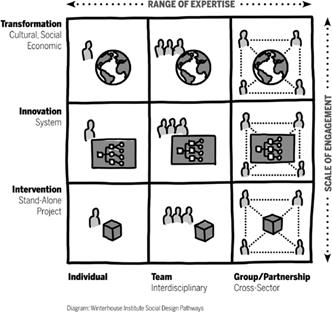
Figure 12 WINTERHOUSE SOCIAL DESIGN PATHWAYS. The Winterhouse social design pathways framework describes the territories and scales at which designers work.
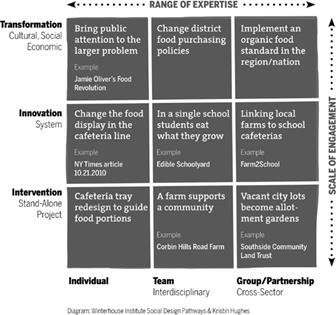
Figure 13. ADDRESSING THE WICKED PROBLEM OF CHILDHOOD OBESITY. The wicked problem of childhood obesity is addressed within the social pathways matrix. The example shows how designed solutions within each of the nine areas might manifest. In order to resolve a wicked problem such as this, multiple interventions at multiple levels of scale over multiple time scales would be required.
(c) as an index for specific skills, resources, and partners necessary for a successful project/solution; and (d) to assess project outcomes and impacts.
The model has also been useful in illustrating the evolution of design (with its origins in the lower left quadrant, evolving toward the upper right) and mapping the broad/expanding territories in which designers are now working (Amatullo, 2016; Irwin et al., 2015). The matrix also encourages designers to take a systems view of designing interventions. Figure 13 shows how a complex problem such as childhood obesity can be addressed using the model. When existing projects and initiatives are mapped onto the matrix, new ideas and themes for connecting projects may emerge. A simple solution such as the redesign of a cafeteria tray that guides the portions of food is situated in the lower left, where a single expert designer can contribute a relatively simple solution from within the discipline of product design. Solutions situated in the upper right-hand side of the matrix involve transdisciplinary teams and are more systemic in their approach, leading to more significant degrees of change. These solutions often involve the redesign of regional or even national policies and infrastructure and designers contribute as members of transdisciplinary teams and are not the sole expert, but rather act as catalysts/facilitators, directing the application of design-led research approaches. To significantly address the problem of childhood obesity, solutions in all areas of the matrix, implemented over long periods of time, would be required. This illustrates how even simple solutions (like a cafeteria tray) can contribute to systems-level change when they are tied to a larger vision and systems strategy. In this way, the matrix can be used as a visioning device to aid teams in planning small interventions that are steps in a mid and long-term, multi-phased process for change. In such cases, the matrix serves as a road-map for change at multiple levels of scale, over longer horizons of time.
Amplifying and linking projects. Two key strategies for designing interventions involve “linking” and “amplifying” projects and initiatives (See Figure 4). Linking new and existing projects and initiatives together (through the co-creation of, short-, mid-, and long-term visions) creates synergistic relationships among them and provides greater leverage for achieving short-and long-term goals. Collectively, these “ecologies” of linked projects serve as both systems interventions and steps along transition pathways toward co-envisioned futures. It is also a strategy for conserving resources and building a wider base of support, and has the potential to ignite exponential change by linking ecologies of interventions in one wicked problem sector to those in other sectors. For instance, strategies and visions aimed at addressing the wicked problem of a city’s lack of affordable housing could simultaneously help resolve the problems of gentrification and speculative overdevelopment. Or linking projects aimed at resolving gentrification with those addressinga lack of access to education or crime could share resources and achieve greater impact. In this way, linking can be both a spatial and temporal system strategy.
Transition Design’s strategy to link “ecologies” of interventions in order to seed systems-level change complements and builds upon other design approaches (Irwin et al., 2015). For example, projects that originate as one-off service design or social innovation solutions, when linked, have the potential to become Transition Design solutions -steps in longer transitions.
The second strategy -amplifying- supports Manzini’s argument (2015, pp. 123-124) that “amplifying grassroots efforts” is an approach to addressing local problems. However, amplifying calls for a decidedly different mindset -that of the non-expert, who approaches a new situation in a posture of empathy and sensitivity to emergent solutions. This is akin to philosopher Ernst Bloch’s notion of latent possibilities or the “not yet” (1995). Sociologist de Sousa Santos describes the not yet as “on the one hand, capacity (potency) and on the other, possibility (potentiality) … [to] identify and enlarge … signals, clues or traces of future possibilities in whatever exists” (de Sousa Santos, 2006, p. 32). This contrasts with the dominant, expert designer mindset and posture that approaches each new situation with the intent to “fix what is wrong” through superior specialist knowledge and experience. Amplifying looks for “what is right” with indigenous, local efforts already underway that can be amplified to become systems interventions.
The Amplifying Creative Communities Project (Penin, 2010, p. 446) was launched with the objectives to:
Find often-hidden examples of people who have organized their own resources for more sustainable city living, learn to create successful alternatives to the standard commercial and government services, help those initiatives become easier and more enjoyable through service design and show others how they could create similar alternatives themselves. (Amplifying Creative Communities, 2010)
In cases like this, the Transition Designer assumes several non-expert roles: an amplifier of grassroots efforts, a connector between previously unrelated projects (via his/her systemslevel view and approach), and a facilitator among stakeholder groups to align goals and develop future visions.
Bringing the approaches together. The approaches presented here (and many more) can aid in designing effective interventions within large spatio-temporal contexts. This is one of the key characteristics of the Transition Design process, making it possible, as described earlier, to (a) understand the present-day ramifications and consequences of wicked problems (looking up and down systems levels); (b) understand how wicked problems evolved and identify their root causes (in the past); and (c) intentionally transition the system toward preferred futures over multiple time horizons.
Phase III-Waiting and Observing. In order to seed and catalyze change in complex systems and resolve wicked problems, multiple interventions, at multiple levels of scale, over multiple time horizons will be required. Working with and within large, slow-moving systems will involve periods of activity and intervention counterbalanced by intervals of observation and reflection in order to understand how the system has responded to the perturbation. This contrasts with traditional, design-led approaches, which are characterized by fast-paced, linear processes whose objective is clear, predictable, conclusive (and often profitable) results (solutions).
Complex systems with large social components (many people interacting with each other) display properties of self-organization, including “the spontaneous emergence of new structures and new forms of behavior” (Capra, 1996, p. 85). Because these systems are self-organizing, the ways in which they react to perturbations from their environment (for instance, how a wicked problem would respond to a series of designed interventions) are internal and self-determined; that is, their response cannot be predicted. This is an extremely important principle that, if properly understood, should radically transform traditional design processes (and would go a long way toward mitigating many of the wicked problems exacerbated by design and designers). Simply put, it is impossible to predict the outcomes of the solutions we design. The context for these interventions -the system itself- will rarely respond to an intervention the way we think it will, and the more complex the system, the more unpredictable its response. This principle of self-organization is why so many meticulously designed solutions fail. Instead of thinking in terms of “designing solutions,” Transition Designers must think in terms of “solutioning” at multiple levels of scale, over long periods of time. Or, as Wheatley and Kellner-Rogers have said, we must learn to “tinker” things into existence (1996, p. 10).
This extremely important part of the Transition Design approach will be highly controversial because it challenges the dominant socio-technical, economic, and political paradigms out of which most wicked problems have arisen. These paradigms are based upon a style of thinking that has been widely critiqued and described in turn as “mechanistic”, “reductionist”, and “de-contextualized” (Irwin 2011b). Sociologist George Ritzer argues that this style of thinking dominates 21st century society via business models characterized by efficiency, calculability, predictability, and control (Ritzer, 2004, pp. 12-15). Transition Design argues that these same characteristics are found in traditional problem-solving process and are -ironically- one of the root causes of wicked problems (Irwin, 2011b).
Designing for systems-level change will require fundamentally different mindsets and postures (Irwin, 2015) and will be slow, patient work with “emergent outcomes”. It will also challenge dominant paradigms that demand fast, concrete, predictable, and profitable results. Orr (2002) makes an important distinction between fast and slow knowledge, arguing that:
The twentieth century is the age of fast knowledge driven by rapid technological change and the rise of the global economy. This has undermined communities, cultures, and religions that once slowed the rate of change and filtered the appropriate knowledge from the cacophony of new information. (p. 36)
The aim of slow knowledge is resilience, harmony and the preservation of patterns that connect (Orr, 2002) and will challenge Transition Designers to adopt a slower pace and the ability to think in longer horizons of time. Stewart Brand of the Long Now Foundation asks, “How do we make long-term thinking automatic and common instead of difficult and rare?” (Brand, 1999, p. 2). Similarly, the “seventh generation” principle from the Great Law of Iroquois Confederacy required its citizens to make crucial decisions with the welfare and preservation of the seventh future generation in mind (Loew, 2014). This type of
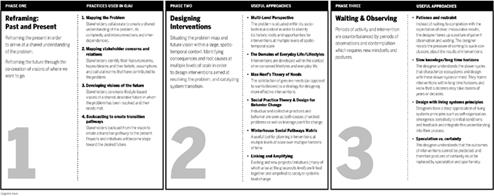
Figure 14 OVERVIEW OF THE EMERGING TRANSITION DESIGN APPROACH. Overview of the emerging Transition Design Approach.
long-term thinking, along with an understanding of the longer, slower cycles that govern the natural world, must underpin Transition Design.
The Transition Design approach could be compared with Chinese acupuncture. An acupuncturist will closely observe the patient for a period of time in order to understand the imbalances or blocks in the system (body) and then place needles along specific meridians in order to shift energy (this is similar to a practitioner designing systems interventions). After placing the needles, the acupuncturist will always wait and observe how the body (system) responds. Sometimes several weeks might go by before another treatment is recommended. The practitioner places needles based upon his/her experience and a working hypothesis that a certain response is probable; however, a good practitioner will wait to see how a specific individual responds (based upon their own physiology, psychology, lifestyle, etc.). Designing interventions for socio-technical systems will require a similar approach in which periods of action and intervention are punctuated by periods of observation and reflection. This process will be at odds with 21st century expectations for quick, conclusive results. Therefore, the Transition Designer will also need to develop compelling arguments and narratives about the (long-term) value and benefits of the process itself.
Conclusion
This paper has outlined an emerging, design-led approach for addressing complex, wicked problems and catalyzing societal transitions toward more sustainable futures (See Figure 14). It emphasizes the need to engage all stakeholders affected by the problem in order to create a shared problem definition and understanding of the oppositions and alignments among them. A framework or “guide” for situating problems within large, spatio-temporal contexts is proposed. This framework can be used to understand root causes and consequences and identify leverage points for interventions aimed at transitioning the system along a transition pathway toward a co-envisioned future.
Transition Design aspires to become a flexible, integrated approach that makes design-led tools and approaches available to transdisciplinary teams working on transition-related projects and initiatives. Still in its nascent phase, it will require researchers and practitioners from many disciplines and a diversity of cultural perspectives working together to constitute a broadly applicable, transdisciplinary process. This paper is presented as an invitation for critique and speculation and as a roadmap for further research.














